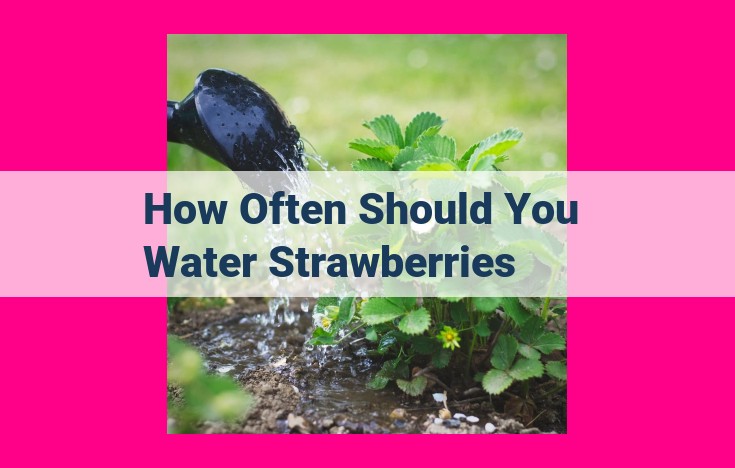Comprehensive Guide To Strawberry Watering: Factors And Recommendations For Optimal Yields

Strawberry watering frequency is influenced by soil characteristics, water source, and watering systems (primary factors). Climate, strawberry variety, and growth stage (secondary and tertiary factors) also play a role. Soil texture, drainage, moisture retention, and water source determine watering intervals. Watering systems (e.g., drip irrigation) provide controlled water delivery, while overhead irrigation may promote disease. Temperature, humidity, and rainfall influence water availability and stress symptoms. Different strawberry varieties have varying watering requirements, and water needs vary during vegetative growth, flowering, and fruiting stages.
Optimizing Strawberry Watering: Primary Factors for Success
When it comes to growing luscious, vibrant strawberries, watering frequency plays a pivotal role. Understanding the key factors that influence watering needs is essential to ensure optimal plant health and bountiful harvests. Let’s delve into the primary factors that demand our attention:
Soil Characteristics
The soil in which your strawberries reside holds great significance in determining watering frequency.
- Texture: Sandy soils drain quickly, necessitating more frequent watering than clayey soils, which retain moisture better.
- Drainage: Well-drained soils allow excess moisture to escape, preventing waterlogged roots and fungal problems.
- Moisture Retention Capacity: Soils with high organic matter content possess excellent moisture retention, reducing watering needs.
Water Source
The availability and quality of your water source can impact strawberry watering practices.
- Wells: Well water is generally free of impurities but may contain high levels of minerals, making it necessary to test pH and nutrient levels.
- Rainwater: Rainwater is an excellent source, but collecting and storing it can be challenging.
- Municipal Supply: Municipal water is reliable but may contain chlorine, which can be detrimental to strawberries.
Types of Watering Systems
Choosing the right watering system can optimize water delivery and minimize waste.
- Drip Irrigation: This highly efficient method delivers water directly to the roots, reducing evaporation and promoting healthy plant growth.
- Overhead Irrigation: Overhead sprinklers cover a larger area but can lead to water loss through evaporation and increased disease susceptibility.
By carefully considering these primary factors, you can establish watering practices that cater to the specific needs of your strawberries, ensuring a thriving harvest and the sweet taste of success.
Secondary Factors Influencing Strawberry Watering: Climatic Conditions
When considering strawberry watering strategies, climatic conditions play a significant role in determining the plants’ needs.
Temperature:
- _Higher temperatures_ increase strawberry water consumption and evaporation. During hot, dry spells, strawberries may require more frequent watering.
- _Cooler temperatures_ result in reduced water loss, allowing for less frequent watering.
Humidity:
- _High humidity_ creates a more humid environment, reducing evaporation rates and allowing strawberries to retain moisture for longer.
- _Low humidity_ accelerates evaporation, increasing the need for more frequent watering.
Rainfall Patterns:
- _Regular rainfall_ can supplement watering needs, reducing the frequency and amount of supplemental watering required.
- _Prolonged dry periods_ can lead to water stress symptoms in strawberries, requiring more frequent and thorough watering.
Understanding these climatic factors helps strawberry growers adjust watering schedules accordingly. By monitoring temperature, humidity, and rainfall patterns, growers can optimize water usage and prevent water stress, maximizing strawberry yields and quality.
Tertiary Factors: Considerations for Strawberry Watering
While not as influential as the primary and secondary factors, tertiary factors still play a role in determining the optimal watering schedule for your strawberries.
Strawberry Variety
Different strawberry varieties exhibit varying levels of sensitivity to water availability. Some varieties, like ‘Albion’ and ‘Chandler,’ can withstand drier conditions, while others, such as ‘Honeoye’ and ‘Earliglow,’ require more frequent watering. When selecting a strawberry variety, consider its watering requirements and choose one that aligns with your growing conditions.
Growth Stage
The watering needs of strawberries change throughout their growth stages. During vegetative growth, when the plant is actively producing leaves and runners, it requires ample water. As the plants begin to flower and fruit, their water requirements gradually increase. During this critical stage, consistent watering is crucial to ensure healthy fruit development and prevent drought stress.